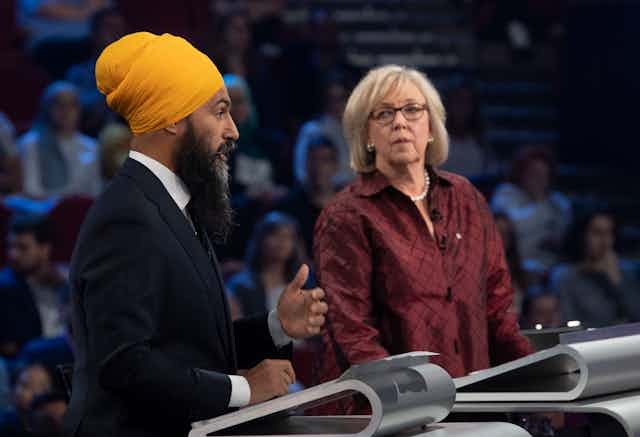As feminist scholars, we have been closely watching the election debates and media coverage to see if and how equity, diversity and gender are discussed. So far, little of substance has been said about how they propose to care for Canadians, particularly those located at the intersections of gender, race and colonial power.
It is therefore no surprise that a recent refinery29 survey of 1,000 women found that 45 per cent of them felt that the government’s actions have had no effect on their lives.
For us, a key question for this upcoming election is how do the key parties propose to care for Canadians, especially those most disadvantaged?
A lens of care
As middle-class academics, we represent a privileged group in society. Nonetheless, we are part of diverse communities whose lived and historic experiences of racism, sexism and various forms of exclusion are inscribed in our collective knowledge, making us deeply aware of the penalties and privileges in the spaces we occupy. For this reason, we have decided to approach this election using a care lens.
A care lens emphasizes relational and contextual approaches to social and political life, focusing on the needs of individuals and of communities. Although care is essential for survival, the idea of “care” has been feminized and in the process, demoted as a concept and relegated to feel-good and nurturing sentiments.
Yet, according to care theorists Joan Tronto and Berenice Fisher, care is “everything that we do to maintain, continue and repair our ‘world,’ so that we can live in it as well as possible. That world includes our bodies, ourselves, and our environment, all of which we seek to interweave in a complex, life-sustaining web.”
Applying a care lens to proposed policies on child care, health and equity forces us to examine which women are likely to be affected the most? Which measures promised in all these platforms actually benefit women’s lives?

Party platforms
Two distinct conceptualizations of care underpin the major party platforms.
For the Liberals and the Conservatives, care is a siloed policy issue, defined narrowly in terms of a service provided. For the NDP and the Green Party, care is viewed as a foundation for a just society.
These perspectives result in vastly different policy orientations.
As a service, the questions of who cares and for whom are obscured, resulting in policy proposals that reproduce systems of oppression and privilege based on class, race and ethnicity, religion, gender, ability and sexuality. For example, when the Liberals promise, “We will take care of the people who take care of us,” they are referring to firefighters, first responders and police officers.
This stance obscures the essential care work of women in families and communities. Similarly, for the Conservatives, who have at this late stage, come out with their full platform, care refers strictly to services such as childcare, homecare and healthcare, masking the full range of care performed by (mostly) women.
When care is conceptualized as a foundation, policy initiatives aim to create a “caring society” based on equality, anti-colonialism, anti-racism and dignity. Only the NDP and the Greens explicitly acknowledge the realities and impacts of racism, as well as the ongoing violence of colonialism, the unique marginalization experienced by Indigenous women and the criminalization of racialized minorities.
They call for structural change to address poverty and discrimination, including targeted measures for women, LGBTQ+, seniors, Indigenous Peoples, people living with disabilities and racialized folks. Thus, there is recognition that how we organize and enable care is political — a choice embedded in multiple and complex power relations.
Shortcomings
At the same time, there remain silences and shortcomings across all of the major parties.
For instance, in increasing access to palliative care and child care none of the platforms effectively address the systemic, chronic and precarious underemployment of the women, often racialized women, who provide care in these situations.
While all the parties embrace gender equity, it is not clear they fully understand the intersectional dimensions of women’s lives. And, most obvious, only the Liberal party has gestured, weakly, to intervening against legislation that discriminates against religious minorities in Québec.
All four political parties promise to end gender-based violence, with the Liberals, NDP and Green Party specifically referencing violence against Indigenous women and the recommendations of the Inquiry into Missing and Murdered Indigenous women.

However, most of the platforms are short on actual policy prescriptions.
The Greens and NDP call for more shelters and address the economic costs of violence. The Greens offer safe, public transit and services in rural areas, while the NDP promises more stable funding for women’s and community organizations. At the same time, the Liberals are offering more funding for research on women’s health issues and paediatric cancer research. For refugees, only the NDP and the Greens promise to dismantle the Third Safe Country agreement with the United States, which has jeopardized the lives of many fleeing from violence.
All party platforms contain promises to fix the current state of the country. Yet, for both the NDP and the Greens, whose platforms offer the most in terms of care for diverse women, there is no past record with which to compare and assess whether these promises are likely to materialize in actual benefits.
Will they be able to walk the talk or are they likely to succumb to the short-sightedness of our governing parties, both present and past? Will the promise to care be realized, or will the power of the status quo prevail?


